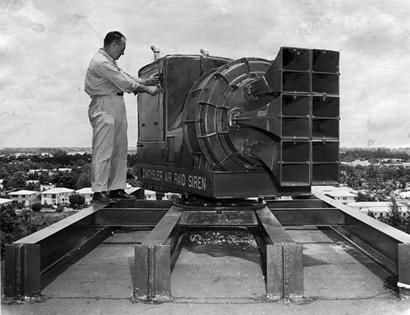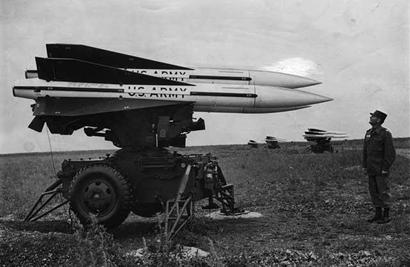|
|
I’ll
admit right here that my role in what is now known as The Cuban Missile
Crisis was actually quite small. I think the movie industry uses the
term “uncredited.” We all know who the main players were but while
they were in Washington, Moscow and Havana, I, on the other hand,
was there where “the rubber was meeting the road.” Like Gertrude Stein’s
Oakland, in the CMC there really was no there there, but I
was as close to a there as one could get if there had been
an actual there.
If the crisis was a board game, I was standing in the shadow of one
of the game’s tokens. I was no more than 500 feet from at least four
ground to ground ICBMs. The only thing between them and me was a one-acre
field of wild castor-bean plants – my boyhood playground. |
|
It was a bit
like this - but much bigger and with a nuclear warhead
Wikimedia Commons
|
|
My father ran
a small hotel in an industrial section of Miami right next to a
railroad spur. The tenants were all working class men in middle
age or older. The hotel was seventy-one blocks from downtown Miami
and we were reminded of that fact every time we looked up at the
sign that said 71st Street. In front of the hotel was a motley group
of lawn chairs and a well-read “library” of paperback books, magazines
and newspapers.
The quality of the reading material might surprise people today.
There were books by Eric Hoffer, Vance Packard, Robert Ruark, Harry
Golden, Alexander King and a copy of Alas, Babylon, the best-selling
novel about nuclear war and its aftermath. I also remember On
the Beach, another nuclear thriller but Alas, Babylon
had a Florida setting and that’s why it was in three pieces while
On the Beach remained intact.
There were also plenty of “men’s magazines” too – with titles like
Argosy, Saga and True. Usually these were filled
with tales from WWII.
The lurid covers showed scantily clad native women (that looked
like well-toned Hedy Lamarr) helping US servicemen hide from Japanese
patrols or else they were bandaging the man’s wounds with cloth
torn from their skirts. The war had ended less than 20 years before
and stories were still surfacing (and being embellished). The women
depicted on the covers bore no resemblance to the grainy actual
photographs inside that would sometimes show a reunion photo between
the serviceman and his rescuer. The women inside the magazine looked
more like their sisters in National Geographic than Hedy Lamarr.
They were also modestly dressed in what appeared to be hand-me-downs
from Missionary wives.
Now
there was talk of a new war – with bigger weapons and more devastating
consequences. Being in Florida increased the anxiety due to its
proximity to Cuba – the potential flashpoint of a war – just like
it was in 1898.
It wasn’t hard to meet someone from Cuba in 1950s Miami. Especially
if you owned a Chevy. My father had a ‘54 Chevrolet sedan and a
week wouldn’t pass without a “scout” from Cuba offering to buy it
so it could be shipped to Havana. It got so bad that my father had
to put a handmade “Not for Sale” sign in the window of the car.
I liked the scouts. They wore suits and hats and most of
them had those little mustaches like older men wore on Perry Mason.
They were also extremely polite and talked like Desi Arnez or Gilbert
Roland. The hotel’s tenants were less polished and looked more like
Ernest Borgnine or an unshaven Lee Marvin.
The “media outlets” of South Florida liked to say that Cuba was
“only 90 miles from US soil” although that was the distance from
Key West to Havana. Everybody in Miami knew that. Key West hadn’t
really been “discovered” at that time and there were people in Miami
in the 50s who may have been surprised to learn that it was even
populated. Most people imagined the keys to be a chain of those
cartoon islands – with sand and a lone coconut tree and nothing
else.
Still, Cuba was close enough to Miami for someone to enjoy an Espresso
and guava paste / cracker breakfast in Havana and eat a corned-beef
sandwich for lunch at Wolfies in Miami Beach – if the drawbridges
on the causeways stayed down.
Just after the man the Cubans now refer to as “The Beard” took over
Cuba, there was great speculation over his intentions. A local television
station (one of three) ran a three part series called “Is Cuba Going
Red?” That’s the way they talked back then. The answer to that blunt
question wasn’t long in coming. Had there been a fourth part to
the series, it would’ve been called “Yep, Cuba Turned Red.”
Living
in an industrial part of town had its disadvantages – not the least
of which was playing host to one of several air raid sirens distributed
around the city. To people in Miami Shores it would’ve been a “distant
siren.” With us, it was “in our face.” Come to think of it, we might
have coined that expression.
|
 |
|
Photo
courtesy Historymiamiarchives.com
|
|
The siren was
mounted atop a five or six story furniture warehouse called Woodruff’s.
Although the Woodruff building had rounded corners, there was nothing
round about the piercing wail of the panel truck-sized, fire-engine
red siren that cranked up every other Saturday at noon.
This siren,
built by the Chrysler Corporation was to small town noon whistles
like a contrabass saxophone is to a kazoo. Thankfully, it rotated,
so you had time to grab some cotton balls or grass or anything handy
to stanch the flow of blood from your ears before it came around
for a coup de grâce. I knew its purpose, but even at my age, I saw
folly in its rigid never-changing schedule. If the Russians were
to attack Miami – all they would have to do is schedule it for an
alternate Saturday at noon.
There was a short warm-up as the beast growled into life. The normal
reaction of residents was either “Oh, no!” or “Has it been two weeks
already?!” It was close enough to us that we could see the service
technician with his five gallon jerry can of fuel. He wore no hearing
protectors, so everyone assumed he was stone deaf – like people
who traditionally worked in newspaper pressrooms.
At that time, public service announcements on radio and television
were telling us to “Sleep well, tonight. Your National Guard is
awake.” Again, I found fault with the premise. If the Guard was
up all night, they’d still be sleeping at noon – just when the Russians
would attack. My strategic acumen came from watching Errol Flynn
Theater (Sundays on Channel Seven). Flynn had battled Nazis, pirates,
Arabs and even the Sheriff of Nottingham. If he hadn’t died in 1959,
he surely would’ve been pressed into service to spoil Soviet plans
in this hemisphere.
Eighteen
months earlier, after the Bay of Pigs fiasco, when “El Commandante”
was ransoming his captured prisoners for tractors, a delegation
from the Cuban army came to Miami to negotiate. Although the more
important negotiators stayed downtown at an expensive hotel, two
of the men came down to my father’s place and rented two rooms for
$2 a day – pocketing the per diem allowance Cuba had given them
for more expensive digs. We hardly ever saw them for the week they
were there, but when they departed they left behind three uniform
shirts with red / black Cuban insignia (and a lot of fruity-smelling
pomade stains on the pillowcases and towels).
Now, at age fifteen, with the first report cards of the semester
due out, I had more important things to worry about than nuclear
war. Yet even I, with my self-centered teenage preoccupation knew
something big was up. Everyone (and I mean everyone) was walking
around with transistor radios up to their ears or remaining within
earshot of a radio.
The railroad spur next to the hotel was actually two sets of tracks
and the assembling or dismantling of a train was a noisy, all-night
process. But like most close-to-the-track dwellers will tell you,
the noise soon becomes a heavy-metal lullaby. But one night in early
October, things were different. Olive drab, nearly windowless railroad
cars were hauled in and parked. Instead of the normal clanging and
the revving of the switching engine’s diesels, it was dead quiet.
The silence itself was ominous.
|
 |
|
Hawk Missiles
in Everglades National Park 1963
Photo courtesy Historymiamiarchives.com
|
|
We instantly
knew they were missiles although no one had ever seen one in real
life. The cars were oversized in that the roofline was taller than
typical passenger cars. They had a sinister look to them. There
were armed sentries at either end of each car and although I was
tempted to tease them into smiling like tourists did at Buckingham
Palace, what I saw was grim determination and fear on their faces
and I decided against it.
The lone phone booth in front of the hotel actually had a line of
people waiting to use it – the only time that ever happened. Several
times I heard men say: ”Well, I better go now, there’s other people
are waiting to use the phone” and I heard each of them say “I love
you” – words that I had never before heard spoken by these crusty,
mostly bitter “old” men. Who was on the other end of the line? Daughters?
Sons? Ex-wives? The men at the hotel seldom spoke of family.
It was a tense time, to be sure, but after three days, we were getting
used to it. The tenants were split – half saying it would never
happen and the other half saying it would. There was talk of Russian
submarines being seen off the Bahamas. The rumor-mill was working
three shifts.
The crisis peaked one night when the warheads were raised by hydraulic
rams and the cars emitted some sort of gaseous cloud that came and
went at intervals. It reminded me of the scene from The Day the
Earth Stood Still where everyone was awaiting the opening of
the spaceship door.
The missile-laden Russian ship was approaching Cuban waters. Some
people even marked its progress on the hurricane tracking charts
that were seasonally imprinted on our paper grocery bags.
The tenants, who normally sat outside to escape the heat of their
un-air conditioned rooms, had gone back inside, possibly to write
letters home or to make out their wills and last testaments. I eventually
fell asleep but periodically checked out the missiles through the
screen of my bedroom window. I didn’t want to miss the launch, should
there be one.
When I awoke,
the missiles were gone along with the guards and the train that
brought them. The relief was palpable. Feuding tenants were suddenly
best friends again and people actually smiled at one another. In
a way, this behavior was nearly as creepy as the threat of war –
but three days later things were back to normal.
August 10, 2014 Column
© John Troesser
More Columns by John Troesser
Relate Topics: Columns
| Texas
|
|
|